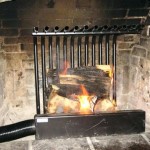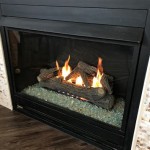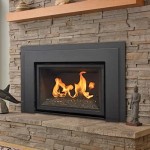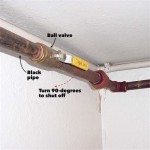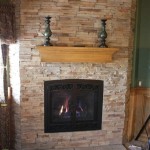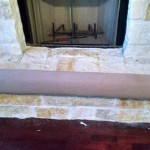Catalytic Fireplace Inserts: Efficiency and Environmental Considerations
Catalytic fireplace inserts represent a significant advancement in wood-burning technology, offering improved efficiency and reduced emissions compared to traditional open fireplaces. These inserts are designed to fit into existing fireplace openings, transforming them into a more effective and environmentally friendly heating source. This article will explore the functionality, benefits, maintenance, and considerations surrounding catalytic fireplace inserts.
The core principle behind a catalytic fireplace insert lies in its use of a catalytic combustor. This component, typically made of a ceramic honeycomb structure coated with precious metals like platinum or palladium, facilitates the combustion of unburned gases and particulate matter present in the smoke. In a conventional wood-burning fireplace, these substances are released into the atmosphere as pollutants. The catalytic combustor significantly reduces these emissions, improving air quality and minimizing environmental impact.
How Catalytic Combustors Work
The process begins as wood burns within the firebox of the insert. As the fire consumes the wood, it releases smoke containing a mixture of gases, including carbon monoxide, hydrocarbons, and particulate matter. These unburned substances represent wasted fuel and pose environmental concerns. The smoke is then channeled through the catalytic combustor. The precious metals coating the combustor act as catalysts, lowering the activation energy required for these gases to ignite. This allows the smoke to ignite at a lower temperature (typically around 500°F/260°C) than would be possible without the catalyst.
This lower ignition temperature facilitates a more complete combustion process. The previously unburned gases and particulate matter are converted into carbon dioxide and water vapor, significantly reducing the amount of harmful pollutants released into the atmosphere. The catalytic combustor essentially acts as a secondary combustion chamber, maximizing the heat extracted from the wood and minimizing waste.
The increased efficiency translates directly to fuel savings. Because more of the wood's energy is converted into heat, less wood is required to achieve the same level of warmth. This not only reduces fuel costs but also contributes to sustainable forestry practices by decreasing the demand for wood.
Benefits of Catalytic Fireplace Inserts
The adoption of catalytic fireplace inserts offers numerous advantages, impacting both the user and the environment. One primary benefit is the improved heating efficiency. Traditional open fireplaces are notoriously inefficient, with a significant portion of the heat escaping up the chimney. Catalytic inserts, on the other hand, are designed to retain and radiate heat into the room, providing a more consistent and effective heating source. The insert's sealed design also prevents drafts and air leaks, further enhancing its heating capabilities.
Another key benefit is the reduction in emissions. By burning off unburned gases and particulate matter, catalytic inserts significantly decrease the amount of smoke and pollutants released into the atmosphere. This contributes to cleaner air quality, both indoors and outdoors, and helps to mitigate the negative impacts of wood burning on the environment. Lower emissions are particularly important in areas where wood burning is a common heating method, as it can help to reduce smog and improve public health.
Furthermore, catalytic inserts offer enhanced safety features compared to open fireplaces. The enclosed firebox prevents sparks and embers from escaping, reducing the risk of accidental fires. Many inserts also come equipped with safety features such as automatic shut-off mechanisms and temperature sensors, providing added protection for the user and their home. The controlled combustion process also reduces the buildup of creosote in the chimney, which can pose a significant fire hazard.
Finally, catalytic inserts provide greater control over the burning process. Most models feature adjustable air intakes, allowing the user to regulate the intensity and duration of the fire. This control enables the user to optimize the heating output based on their specific needs and preferences, ensuring a comfortable and efficient heating experience.
Maintenance and Operational Considerations
While catalytic fireplace inserts offer numerous benefits, proper maintenance and operation are crucial to ensure optimal performance and longevity. Regular cleaning of the insert and chimney is essential to prevent creosote buildup and maintain efficient airflow. Creosote is a flammable byproduct of wood burning that can accumulate in the chimney over time, increasing the risk of chimney fires. A professional chimney sweep should be hired to inspect and clean the chimney at least once a year, or more frequently depending on usage.
The catalytic combustor itself requires periodic inspection and cleaning. Over time, the combustor can become clogged with ash and other debris, reducing its efficiency. Some combustors can be cleaned using a soft brush or vacuum cleaner, while others may need to be replaced. The lifespan of a catalytic combustor typically ranges from three to five years, depending on usage and maintenance practices. Following the manufacturer’s recommendations for cleaning and replacement is essential for maintaining the insert’s efficiency and maximizing its lifespan.
Proper wood selection is also crucial for optimal performance and reduced emissions. Using seasoned (dried) wood is essential for clean and efficient burning. Wood that is too wet will produce excessive smoke and creosote, reducing the efficiency of the combustor and increasing the risk of chimney fires. Hardwoods such as oak, maple, and ash are generally preferred over softwoods like pine, as they burn longer and produce less smoke. It is important to store wood properly to ensure that it remains dry and ready for use.
Finally, it is important to operate the insert according to the manufacturer’s instructions. Overloading the firebox or using improper fuels can damage the insert and reduce its efficiency. Proper airflow is also essential for optimal combustion. Ensure that the air intakes are not blocked and that the chimney is properly vented. Following these guidelines will help to ensure that the catalytic fireplace insert operates safely and efficiently for many years to come.
In addition to regular maintenance, users should also be aware of potential issues that may arise with catalytic fireplace inserts. These can include problems with the catalytic combustor, such as clogging or deterioration, as well as issues with the air intake system or the chimney. If the insert is not burning properly or if smoke is escaping into the room, it is important to address the issue promptly to prevent further damage and ensure safety.
Troubleshooting common problems often involves checking the catalytic combustor for clogs or damage, inspecting the air intake system for obstructions, and ensuring that the chimney is properly cleaned and vented. If the problem persists, it may be necessary to consult with a qualified technician to diagnose and repair the issue. Regular maintenance and prompt attention to potential problems are essential for ensuring the long-term performance and reliability of a catalytic fireplace insert.
The cost of catalytic fireplace inserts can vary depending on the size, features, and brand of the unit. While the initial investment may be higher than that of a traditional fireplace or a non-catalytic insert, the long-term savings in fuel costs and reduced emissions can often offset the initial expense. Furthermore, many government agencies and utility companies offer incentives and rebates for the purchase of energy-efficient heating appliances, which can help to reduce the upfront cost of a catalytic fireplace insert.
When considering the purchase of a catalytic fireplace insert, it is important to compare different models and features to find the unit that best meets your specific needs and budget. Factors to consider include the size of the area to be heated, the type of wood to be burned, the desired level of control over the burning process, and the aesthetic appeal of the insert. Consulting with a qualified dealer or installer can help to ensure that you choose the right unit for your home and that it is installed properly.

Hi500 Hybrid Catalytic Cast Iron Wood Burning Insert By Regency

Hi500 Hybrid Catalytic Cast Iron Wood Burning Insert By Regency

Superior Catalytic Combustion Wood Burning Fireplace Double Black Steel Doors Wct6940ws

Hampton Hi500 Hybrid Catalytic Wood Insert On Display In Our Portland Fireplace

Regency Cascades I2500 Hybrid Catalytic Wood Insert Toronto Home Comfort

Hi500 Hybrid Catalytic Cast Iron Wood Burning Insert By Regency

Wood Burning Inserts Buck Stove

Regency Cascades Small I1500 Hybrid Catalytic Wood Insert Toronto Home Comfort

Regency Ci2700 Catalytic Wood Insert Vaglio Fireplace

Regency Cascades I2500 Hybrid Catalytic Wood Insert Toronto Home Comfort


